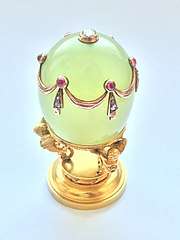Egg-Stamp (Fabergé egg)
| Egg-Stamp Fabergé egg | |
|---|---|
 | |
| Year delivered | 1895 |
| Customer | Vasily Denisov |
| Recipient | Vasily Denisov |
| Current owner | |
| Individual or institution | private collection |
| Year of acquisition | 2011 |
| Design and materials | |
| Workmaster | Michael_Perkhin |
| Materials used | Gold, rubys, diamonds |
| Height | 60 mm |
Egg-Stamp – a jewelry Easter egg created by Mikhail Perkhin under auspices of Carl Faberge in 1895, for Vasily Denisov.
Description
Egg-Stamp, made of red gold, surrounding the upper part of the Egg and bowenite, decorated with 19 diamonds, is with 19 diamonds which includes one large diamond – at the top of the Egg six rubies- cabochons on garlands, and three rubies – cabochons on the Chest of the cherubs. The egg is supported by the three cherubs standing at bottom of the stamp.
The coat of arms carved on the golden base of the Stamp belongs to the historically famous representative of the branch of the famous Denisov Cossack genus, the descendants of the Guards captain of horse Vasily Denisov.[1] General armorial of imperial Russia. Part XVIII, № 4.
History
Egg-stamp was manufactured for Vasily Denisov, as the a personal stamp. Peculiarity of the subject is in its historical, artistic and scientific unprecedented and unique. The level of work is worthy only of the imperial collection. The first bavenite Imperial egg with a diamond "net" in platinum was carried out in 1892.
Putti – Cherubim (winged boys, favorite motive of the Italian Baroque) are present in the Imperial Easter Egg of 1888 and in the famous Clock for the Silver wedding of Emperor Alexander and Empress Maria Feodorovna, execute by Faberge company and master Mikhail Perkhin in 1891, upon the project of the court architect Leontius Benois . The quality of the execution of the Cherubs, the elaboration of details, incusing and engraving – at the ideal level. Stamps for individuals were seldom executed on an individual commission, most of the stamps made by Faberge company for members of the Imperial Family. The cost of engraving was fathomless higher than the cost of the material. There are job prices: the cost of an agate matrix is 3 roubles, engraving of a stamps – 50 roubles.
Even in the Faberge firm of master engravers of the highest qualification there were only a few people.
The stamp in Petrograd was obtained by a Finnish enterpriser, a grain bargainer and transported to Finland by its owner during the October Revolution of 1917. The family is in possession of the subject until 1989. In 1995, the grandson of the Finnish entrepreneur bequeathed the Egg-seal to his sisters. In 1995, the grandson of the Finnish enterpriser
bequeathed the Egg-stamp to his sisters. In the will it is indicated that the coat of arms depicted on the stamp belonged to Duke Rakhlin-Rumiantsev, who was once Russia's ambassador to Sweden.
However, the idea that the Egg-stamp belonged to Duke Rakhlin-Rumyantsev[2], and presumably his coat of arms was engraved on the bottom (as was indicated in the will) during the research, was refuted, since in history there is no mention of a certain prince Rakhlin-Rumyantsev.

Confusion, probably, arose as a result of the personal tragedy of Vasily Denisov. One of the sons fled the house, stealing diamonds and jewelry worth at the cost of two hundred thousand rubles. It is in contemplation that the egg was sold under false name, in order to hide the son's implication of the son.[3]
Stamp
The stamp- is the mark "M.P" (After 1895, the point in the middle, in the oval: Mikhail Perkhin). The stamp -a double for the St. Petersburg Assay department 1895-Dec. 1898 years. with the designation of purity of gold "56" in the spool measurement, which corresponds to the 583rd metric purity and the coat of arms of St. Petersburg ("anchors").
Owners

After the Vasily Denisov's loss of the stamp , it was obtained by a Finnish enterpriser in Petrograd, a grain bargainer and taken to Finland by its owner during the Rissian Revolution of 1917. The family possessed the subject until 1989. It was at the auction by the Bukovskys (Helsinki) in 1981 (not sold), in 1989 the stamp was estimated by the expert of the Auction House "Christie" Mr. A. de Tiesenhausen, who confirmed the identity of the object and its affiliation to Faberge company.
References
- ↑ "Герб рода дворян Денисовых". gerbovnik.ru. Retrieved 2 July 2018.
- ↑ "Bukowskis Helsingfors International Spring Sale, Helsinki 25- 26 May". Artnet Scandinavia (in Swedish). Retrieved 2 July 2018.
- ↑ "Штрихи к портрету донского предпринимателя Василия Денисова". Российская газета (in Russian). 4 March 2016. Retrieved 2 July 2018.
| Wikimedia Commons has media related to Egg-Stamp (Fabergé egg). |